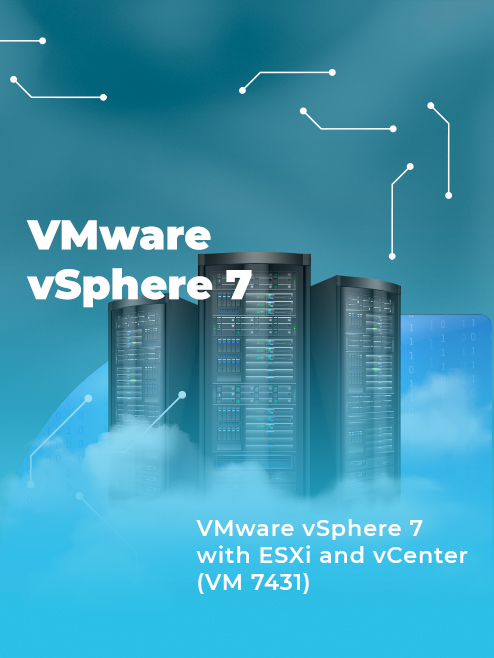Poželjno predznanje:
Polaznici treba da imaju operativno i administrativno iskustvo u radu na operativnim sistemima kao što su Windows, Linux, etc. Takođe i iskustvo u instaliranju, konfiguraciji i menadžmentu OS, storage sistema i mreža može biti korisno ali nije uslov. Pretpostavka je da svi polaznici imaju iskustva i u osnovi upoznati su sa PC i serverskim hardverom, IP protokolom, instaliranjem OS, mrežnim tehnologijama itd.
Plan obuke:
Module 1: Introduction to VMware vSphere 7.0
- Virtualization explained
- How VMware virtualization compares to traditional PC deployments
- Common pain points in PC Server management
- How virtualization effectively addresses common IT issues
- VMware vSphere software products
- What’s New in vSphere 7
Module 2: How to Install, Configure VMware ESXi 7.0
- Understanding ESXi
- Selecting, validating, and preparing your server
- Storage controllers, disks, and partitions
- Software installation and best practices
- Join ESXi to a Domain
- Local User Management and Policies
- First look at VMware Host Client
Module 3: Introduction to Virtual Networking
- vNetwork standard virtual Switches
- Virtual Switches, Ports, and Port Groups
- Creating VMkernel NICs
- Creating, sizing, and customizing Virtual Switches
Module 4: Network Attached Storage & Network File System
- Benefits Shared Storage offer to Virtual Infrastructure
- NFS Overview
- Configuring ESX to use NFS Shares
- Configuring NFS for performance and redundancy
- NFS Use Cases
- Troubleshooting NFS connections
Module 5: Virtual Hardware and Virtual Machines
- VM virtual hardware, options, and limits
- Sizing and creating a new VM
- Assigning, modifying, and removing Virtual Hardware
- Working with a VM’s BIOS
- VMware remote console applications
- Installing an OS into a VM
- Driver installation and customization
Module 6: vSphere 7.0 Management with vCenter Server Appliance (vCSA)
- The need for Identity Source management
- Installing and configuring vCenter Server Appliance with an embedded Platform Service Controller
- Connecting Single Sign On (SSO) to Active Directory and other identity sources
- vCenter feature overview and components
- Organizing vCenter’s inventory views
- Importing ESX hosts into vCenter management
- Administering vCenter Server with vSphere Client
Module 7: Rapid VM Deployment with Templates, Clones
- Templates – Virtual Machine Golden Master images
- Creating, modifying, updating, and working with Templates
- Patching, and refreshing Templates
- Cloning, one time copies of VMs
- Best practices for cloning and templating
- Adding and resizing virtual disks
- Hotplug VM virtual CPUs and Memory
Module 8: Working with VM Hot Plug Virtual Hardware
- Upgrade VM Hardware with no downtime with hotplug virtual hardware
- Preparing to hotplug vCPUs and vRAM into a running VM
- Hotplug vNICs and vDisks into a running VM
- Hotplug Hardware and Guest OS support
Module 9: ESXi and vCenter Security & Permission Model
- VMware Security model
- Configuring local users and groups
- Managing local permissions
- vCenter security model
- Local, Domain, and Active Directory users and groups
- How permissions are applied
Module 10: Fibre, iSCSI SAN and NFS v4.1 NAS Shared Storage
- Fibre SAN overview
- Identifying and using Fibre Host Bus Adapters
- Scanning and Rescanning Fibre SANs
- iSCSI overview
- Virtual and physical iSCSI adapters
- Connecting to iSCSI storage
- Scanning and rescanning iSCSI SANS
- Performance and redundancy considerations and best practices
- Understanding the benefits of VMware VAAI compliant storage
Module 11: VMFS 6 VMware’s Cluster File System
- Unique file system properties of VMFS 6
- Managing shared Volumes
- Creating new VMFS partitions
- Explanation of VMFS 6 features and capabilities
- Managing VMFS capacity with LUN spanning and LUN expansion
- Native and 3rd party Multipathing with Fibre and iSCSI SANs
- VMFS performance considerations
- VMFS scalability and reliability
Module 12: Virtual Infrastructure Monitoring with vCenter Alarms
- Alarm categories and definitions
- Creating custom alarms and actions
- Configure vCenter so it can send E-mail and SNMP alerts
- Reviewing alarms and acknowledging them
- Work with alarm conditions, triggers, and actions
- Identify the most useful alarms to review and enable
Module 13: Compute Resource Management and Resource Pools
- Delegate resources in bulk using Resource Pools
- How ESX delivers resources to VMs
- Shares, Reservations, and Limits
- CPU resource scheduling
- Memory resource scheduling
- Resource Pools
Module 14: Cold VM Migration, VMotion Migration, and Storage VMotion Migration
- Cold VM migrations to new ESX hosts, datastores
- Hot Migrations with VMotion
- VMotion requirements and dependencies
- How VMotion works – detailed explanation
- Troubleshooting VMotion
- How to test hosts for VMotion compatibility
- Storage VMotion for hot VM disk migrations
Module 15: VMware Distributed Resource Scheduling Clusters
- CPU and Memory resource balanced clusters with VMware Distributed Resource Scheduler
- DRS Cluster configuration and tuning
- Per-VM cluster policy overrides
- Learn the features and benefits of DRS Power Management
Module 16: VMware High Availability Clusters
- High Availability options to minimize unplanned downtime
- How VMware HA protects against ESXi host, storage network, and SAN volume failures
- Understand and review HA’s many policies
- Introduction to continuous VM availability using VMware Fault Tolerance
Module 17: VMware Lifecycle Manager
- Configure and enable VMware Lifecycle Manager
- Establishing a patch baseline
- Verifying compliance and patching ESXi hosts
Module 18: vSphere 7.0 Performance Analysis and Tuning
- VMkernel CPU and memory resource management mechanisms
- Tuning VM storage I/O performance
- Identifying and resolving resource contention
- Monitoring VM and ESX host performance
- Performance and capacity planning strategies
Module 19: vSphere 7.0 Final Thoughts
- Consolidation guidelines for VMs and Storage
- Determining which workloads to consolidate
- Useful books, white papers, and online resources

